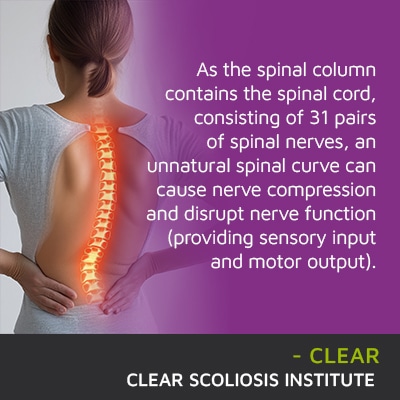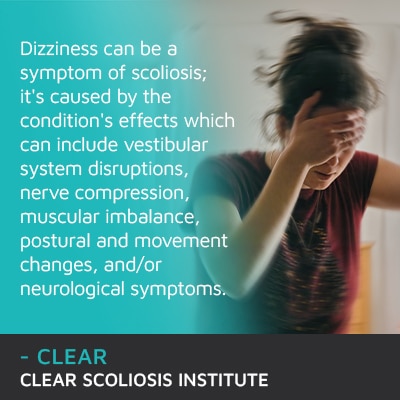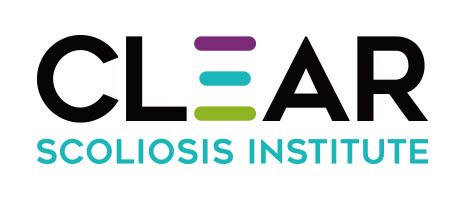
As dizziness can be a symptom of scoliosis, for any type of long-term relief, its underlying cause has to be addressed: the condition itself. If scoliosis is treated proactively and effectively, its symptoms can be improved and/or reversed.
Scoliosis can cause dizziness by disrupting the vestibular system, nerve compression, causing a muscular imbalance, disruptions to the flow of cerebrospinal fluid (CSF) and neurological symptoms.
The effects of scoliosis can be widespread throughout the body, and the best way to minimize its potential effects is with proactive treatment.
Scoliosis causes the spine to bend unnaturally to the side and rotate, making it a 3-dimensional spinal condition, and the spine's unnatural bend and twist introduces a lot of uneven forces not just to the spine, but also its surroundings, and the entire body.
The further out of alignment the spine is, the more out of balance the entire body is, and this can cause a number of effects involving postural deviation, pain, muscular imbalance, and changes to movement including gait, coordination, and balance.
The most noticeable symptoms of scoliosis in children are postural changes such as uneven shoulders and hips, and the main symptom of adult scoliosis is pain.
It's also important to understand that not all scoliosis patients will experience dizziness. Scoliosis ranges widely in severity from mild scoliosis to moderate and severe scoliosis, and the more severe scoliosis is, the more noticeable its effects are going to be.
Mild scoliosis isn't associated with many noticeable symptoms, but when/if progression occurs, this is when symptoms tend to become noticeable, but many can be prevented with proactive treatment.
One of the main ways scoliosis can cause dizziness is by affecting the vestibular system.
Scoliosis can be associated with dizziness because of how it can impact the vestibular system; in fact, there are even theories suggesting vestibular disorders can be a contributing factor in idiopathic scoliosis onset.
The vestibular system is a sensory system in the inner ear; it helps facilitate balance and spatial orientation. It feels the effects of head movements and delivers feedback to the brain involving eye movement and posture.
The vestibular system provides important feedback on balance, posture, and movement to the brain.
The spine and brain work together to form the central nervous system (CNS): a vast communication network that facilitates communication between the brain, the spine, and the entire body.

Scoliosis is also known to cause disruptions to movement and proprioception: the body's ability to orient its position without visual cues.
So scoliosis can affect the brain's ability to perceive its orientation and position of the body by impacting the vestibular system, potentially causing feelings of dizziness and being off balance.
Scoliosis is also associated with muscular imbalance. A focus of scoliosis treatment is on the spine's surrounding muscles: improving their balance and strength.
The spine needs support and stability from its surrounding muscles, and an unnatural spinal curve can pull those muscles in different directions.
Muscles on one side of the spine can become sore and strained from trying to counteract the unnatural position of the spine, while muscles on the opposite side can become weak from lack of use.
Scoliosis symptoms can include muscle pain, muscular imbalance, and muscle spasms.
If a muscular imbalance has developed that disrupts the body's ability to maintain a straight and upright posture, this can contribute to being off balance.
A misaligned spine means a misaligned body, and disruptions to balance and dizziness may occur.
Scoliosis can also affect the vestibular system if it compresses a nerve that's connected to the inner ear.
Scoliosis introduces uneven forces to the spine and its surroundings, including its nerves, and nerve compression can cause a variety of symptoms due to nerve dysfunction and/or irritation.
If a nerve that connects to the inner ear is compressed, it can cause vertigo symptoms: strange sensations of spinning and being off balance, lightheadedness, floating sensations, headaches and dizziness.
Cerebrospinal fluid (CSF) cushions the brain and spinal cord; it flows between the brain and spine providing protection, nourishment, regulating pressure, and removing waste.
Cerebrospinal fluid helps stabilize the central nervous system (brain and spine).
Scoliosis can cause a disruption to the flow of CSF in and around the brain because of the spine's unnatural bend and twist.
Disruptions to the flow of cerebrospinal fluid can have a number of effects including headaches capable of causing dizziness, and if the stability of the central nervous system is disrupted for any reason, it can cause a number of sensations, including dizziness and issues with balance and coordination.
Neurological symptoms can develop when there is an issue with the nervous system.
While mild scoliosis isn't commonly associated with neurological symptoms and functional deficits, increasing progression and condition severity can cause the emergence of new symptoms, hence the benefit of a proactive treatment approach.
Neurological symptoms can include motor symptoms: issues with movement, muscle weakness, changes to coordination and balance, and/or sensory symptoms like numbness, tingling, and strange sensations. Cognitive problems can also arise such as brain fog.
So now that we have discussed some potential causes of scoliosis-related dizziness, let's talk about relief options.
For scoliosis patients experiencing dizziness, the best relief can be provided through treating the condition effectively.

For any type of long-term sustainable symptom relief, its underlying cause has to be addressed, so the scoliosis has to be treated, and as a structural spinal condition, the spine's structural abnormality has to be addressed.
Here at the CLEAR Scoliosis Institute, the treatment approach is conservative and proactive and is started immediately following a diagnosis.
As a progressive condition triggered by growth, particularly cases of childhood scoliosis can progress quickly.
The goal of being proactive with treatment is working towards preventing progression because this spares patients the challenges of increasing condition severity and the need for invasive surgical treatment in the future.
The more a condition progresses, the more symptoms it's capable of causing, and scoliosis that's left untreated can cause a number of complications that, in many cases, may have been preventable.
The CLEAR approach is chiropractic-centered, and through a number of techniques and adjustments, the spine's unnatural curve may be improved by working towards realigning the spine.
The structural changes within the spine are then supported by strong and balanced muscles: worked towards through the application of scoliosis-specific physical therapy and scoliosis-specific exercises.
An abnormal curvature of the spine needs to be taken seriously because of the connection between spinal health and overall health.
What's most important for scoliosis patients, and their families, to understand is that scoliosis is not a static condition.
As a progressive condition triggered by growth, scoliosis can change quickly so needs to be taken seriously and treated proactively; just because scoliosis is capable of causing effects like dizziness doesn't mean it has to.
The best way to address any symptom of scoliosis is to treat the condition itself, as its uneven forces are the underlying cause of the condition's effects.
Scoliosis can cause dizziness for different reasons; it can cause postural changes that disrupt the body's symmetry and balance. Scoliosis can also compress a nerve that connects to the inner ear, disrupting the vestibular system that's involved in balance.
A muscular imbalance can develop that makes it harder to maintain a healthy upright posture. Scoliosis can also cause issues with the flow of cerebrospinal fluid in and around the brain, and this can destabilize the central nervous system.
Scoliosis can also cause dizziness due to neurological symptoms caused by issues within the central nervous system; remember, as the brain and spine form the central nervous system, spinal conditions/injuries can affect the CNS in a number of ways.
When it comes to scoliosis-related dizziness, restoring the spine's healthy curves and alignment, and working to improve the spine's surrounding muscle strength and balance, can improve dizziness by restoring balance to the spine and body.

CLEAR provides a unique and innovative way of understanding scoliosis. Sign up to receive facts and information you won’t find anywhere else.
